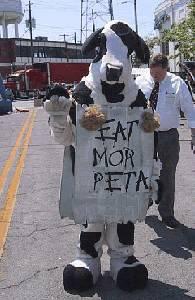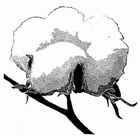Things are bigger in...
OK, so the background picture has changed, along with pretty much everything else. The photo is relevant to me, because it is a cotton field. Unfortunately for the relevance factor, it is a cotton field in "the dry cotton area" of West Texas. (Childress County, to be precise.) The photo was an illustration to a story in a June, 1938 newspaper detailing how tractors were putting sharecroppers off their land*, a la Grapes Of Wrath. I really like Grapes of Wrath, but only for the quality of the writing. The depictions of Okies as too stupid to scratch themselves show Steinbeck up for the product of an affluent middle class Coast family that he was. The descriptions of families being 'tractored off' their farms is, apparently, accurate. Oh well, it worked out OK in the long run. I really don't understand the maudlin sentimentality that accompanies any discussion of these events.
Who in their right mind would want to get up before sparrow fart, eat porridge for breakfast, then work your nuts off for twelve or fourteen hours a day, all so you could pay off some of your debt at the local store - maybe? If you were real lucky, maybe your eldest kid could get brand new shoes every couple of years.
Fuck that for a game of soldiers. My Dear Old Daddy did his apprenticeship as an epilectic with one foot nailed to the floor**. At trade school they showed a movie provided by William Adams, who were the Caterpillar distributors. The movie showed two blokes operating three cats. One bloke stood about 100 metres in from each end of the paddock and when a tractor and plough got close enough he'd run in between the plough and tractor, climb over the back of the seat, lift the plough up, turn around and send it back the other way - jumping off when he was satisfied it was going straight. Try getting that past the OH&S people these days...
And yes, I do know that the hills in the photo are extremely unlikely to have been pulled by a Caterpillar, being such fluent curves, but Caterpillar was the tenant-farm-destruction weapon of choice in large areas of the You-ess.
As an aside, I find this picture baffling. Those aren't fresh hills. That ground has been worked up at least once since those hills were pulled, which raises some questions. Does 'dry cotton area' mean an area where they grow dryland (i.e., non-irrigated) cotton, or is an area of low rainfall where they grow irrigated cotton? See, if it's irrigated, why do they pull their hills into curves? It's bloody hard to do surface - furrow irrigation around corners and I would doubt that they had centre pivots. If it's dryland, why pull hills? And why put so much work on the dirt? Hills dry out quicker than flat ground, leading your plants into moisture deficit earlier than they otherwise would; therefore increasing the amount of squares and bolls the plant sheds. It also reduces fibre quality and yield on the remaining bolls. Working the dirt costs you moisture as well.
Life is full of little mysteries.
*Of course, several years of drought (The Oklahoma Dustbowl, anybody) and The Great Depression had nothing to do with it.
**Epilectics with one foot nailed to the floor are also known as fitters and turners.




3 Comments:
I guess that's why I'm not a dirt farmer... I don't know shit about it...
As for the timber of Steinbeck, I've been to Oklahoma and he wasn't too far from the mark...
The Gripes of Wrath.
A fella called John Rooth used to edit a motorcycle magazine (don't remember which one). His editorial page was called The Gripes of Rooth.
Post a Comment
<< Home